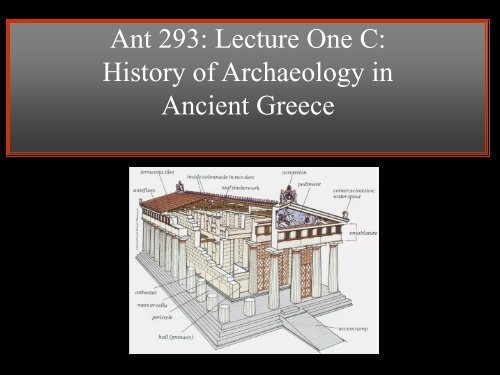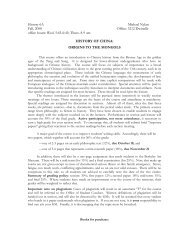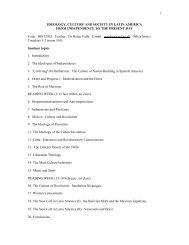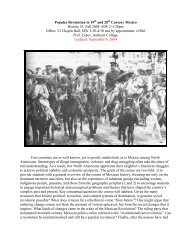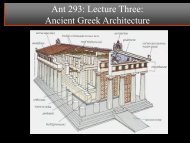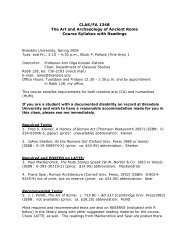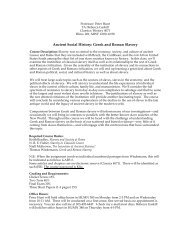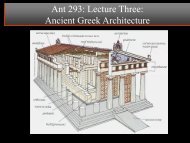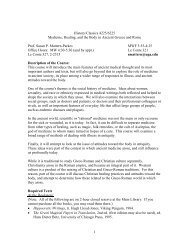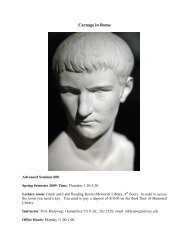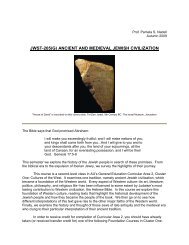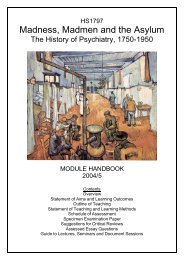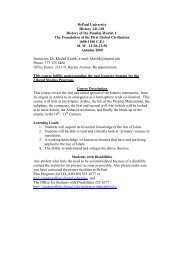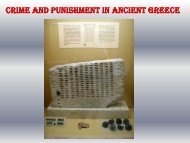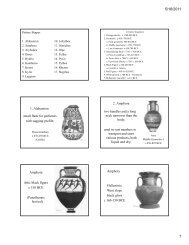Ant 293: Lecture One C: History of Archaeology in Ancient Greece
Ant 293: Lecture One C: History of Archaeology in Ancient Greece
Ant 293: Lecture One C: History of Archaeology in Ancient Greece
You also want an ePaper? Increase the reach of your titles
YUMPU automatically turns print PDFs into web optimized ePapers that Google loves.
<strong>Ant</strong> <strong>293</strong>: <strong>Lecture</strong> <strong>One</strong> C:<br />
<strong>History</strong> <strong>of</strong> <strong>Archaeology</strong> <strong>in</strong><br />
<strong>Ancient</strong> <strong>Greece</strong>
Discipl<strong>in</strong>es <strong>of</strong> Classical <strong>Greece</strong> Studies<br />
Philology: the study <strong>of</strong> language <strong>in</strong> written<br />
historical sources;<br />
Political history<br />
<strong>History</strong> <strong>of</strong> art and architecture
S<strong>in</strong>ce the end <strong>of</strong> the Middle Ages, classical<br />
archaeology has gone through several<br />
periods, each marked by one type <strong>of</strong><br />
<strong>in</strong>formation:<br />
1. literary texts;<br />
2. works <strong>of</strong> art;<br />
3. sites and “material culture”;
Each phase represents a change <strong>in</strong> the<br />
approach and perception <strong>of</strong> Greek<br />
antiquity;
1. Literary Texts<br />
Manuscripts<br />
apart from a few visible monuments and<br />
some artifacts found by chance, classical<br />
antiquity survived dur<strong>in</strong>g the Middle Ages<br />
thanks to manuscripts;
After the fall <strong>of</strong> Constant<strong>in</strong>ople <strong>in</strong> 1453,<br />
Greek <strong>in</strong>tellectuals brought classical<br />
manuscripts to Italy;<br />
The Venetian pr<strong>in</strong>ter Aldus Manutius<br />
systematically published the Greek authors<br />
<strong>in</strong> 1494;
from the beg<strong>in</strong>n<strong>in</strong>g <strong>of</strong> the 16th C, the<br />
Humanist movement spread to the rest <strong>of</strong><br />
Europe;<br />
<strong>in</strong> 1530, Francois I founded the College de<br />
France to study antique texts;<br />
for 3 centuries knowledge <strong>of</strong> th<strong>in</strong>gs ancient<br />
Greek was based on ancient texts that were<br />
constantly re-edited and commented on;
2. Works <strong>of</strong> Art<br />
the study <strong>of</strong> works <strong>of</strong> art and monuments<br />
began to give classical archaeology an<br />
aesthetic and concrete orientation by the<br />
end <strong>of</strong> the 18th C;
a. types <strong>of</strong> collections before museums<br />
i. cab<strong>in</strong>et: <strong>in</strong> which small valuable objects<br />
were collected and displayed;<br />
ii. villa: sculptures were an essential feature<br />
<strong>of</strong> the „antique‟ atmosphere;<br />
iii. regional: <strong>in</strong> England, the Earl <strong>of</strong> Arundel<br />
assembled the first collection <strong>of</strong> objects<br />
com<strong>in</strong>g exclusively from <strong>Greece</strong>;
. new approaches<br />
W<strong>in</strong>kelmann (1717-1768) sought to put an<br />
end to the chaos caused by the confus<strong>in</strong>g<br />
zeal and confusion <strong>of</strong> the <strong>Ant</strong>iquarians;<br />
his <strong>History</strong> <strong>of</strong> <strong>Ancient</strong> Art <strong>in</strong> 1764 marked<br />
the emergence <strong>of</strong> a genu<strong>in</strong>e history <strong>of</strong><br />
antique art;<br />
this work had great <strong>in</strong>fluence on 19th C<br />
th<strong>in</strong>kers on history, anthropology and<br />
archaeology;
c. ref<strong>in</strong>ement <strong>of</strong> stylistic criticism: late 19 th<br />
Century<br />
Began to shift the view away from Athenian<br />
classicism be<strong>in</strong>g the high po<strong>in</strong>t <strong>of</strong> Greek<br />
art;<br />
the different periods <strong>of</strong> Greek art appeared <strong>in</strong><br />
all their <strong>in</strong>dividuality, and from then on the<br />
orig<strong>in</strong>ality <strong>of</strong> regional styles <strong>in</strong> all periods<br />
were recognized;
3. Sites and „material culture‟: predatory<br />
archaeology<br />
the enthusiasm for antique objects led to<br />
their systematic research, firstly <strong>in</strong> Italy<br />
and then <strong>in</strong> <strong>Greece</strong> and the Near East;
In 1801-3, Lord Elg<strong>in</strong> removed from Athens<br />
sculptures and blocks <strong>of</strong> architecture from<br />
the Acropolis and these were bought by<br />
the British Museum <strong>in</strong> 1816;
the transfer <strong>of</strong> artifacts and whole<br />
monuments to the great European<br />
museums only came to a halt with the<br />
formation <strong>of</strong> national states<br />
<strong>Greece</strong>: 1832<br />
Italy: 1860<br />
Turkey: 1920
New Approaches to classical archaeology<br />
By the end <strong>of</strong> the 19th C, excavations at<br />
Olympia marked the beg<strong>in</strong>n<strong>in</strong>gs <strong>of</strong><br />
stratigraphy;<br />
s<strong>in</strong>ce WWII, the <strong>in</strong>creas<strong>in</strong>gly detailed work<br />
<strong>of</strong> excavation has turned public <strong>in</strong>terest<br />
towards social and economic history;<br />
it is now the „archaeology <strong>of</strong> society‟;
a. techniques<br />
• data process<strong>in</strong>g<br />
• remote sens<strong>in</strong>g<br />
• trace element analysis<br />
• GIS
. ongo<strong>in</strong>g frictions<br />
there is a lively discussion between<br />
supporters <strong>of</strong> the new social quantitative<br />
archeology and the upholders <strong>of</strong> traditional<br />
archaeology, oriented to literary sources,<br />
artifacts and monuments;


